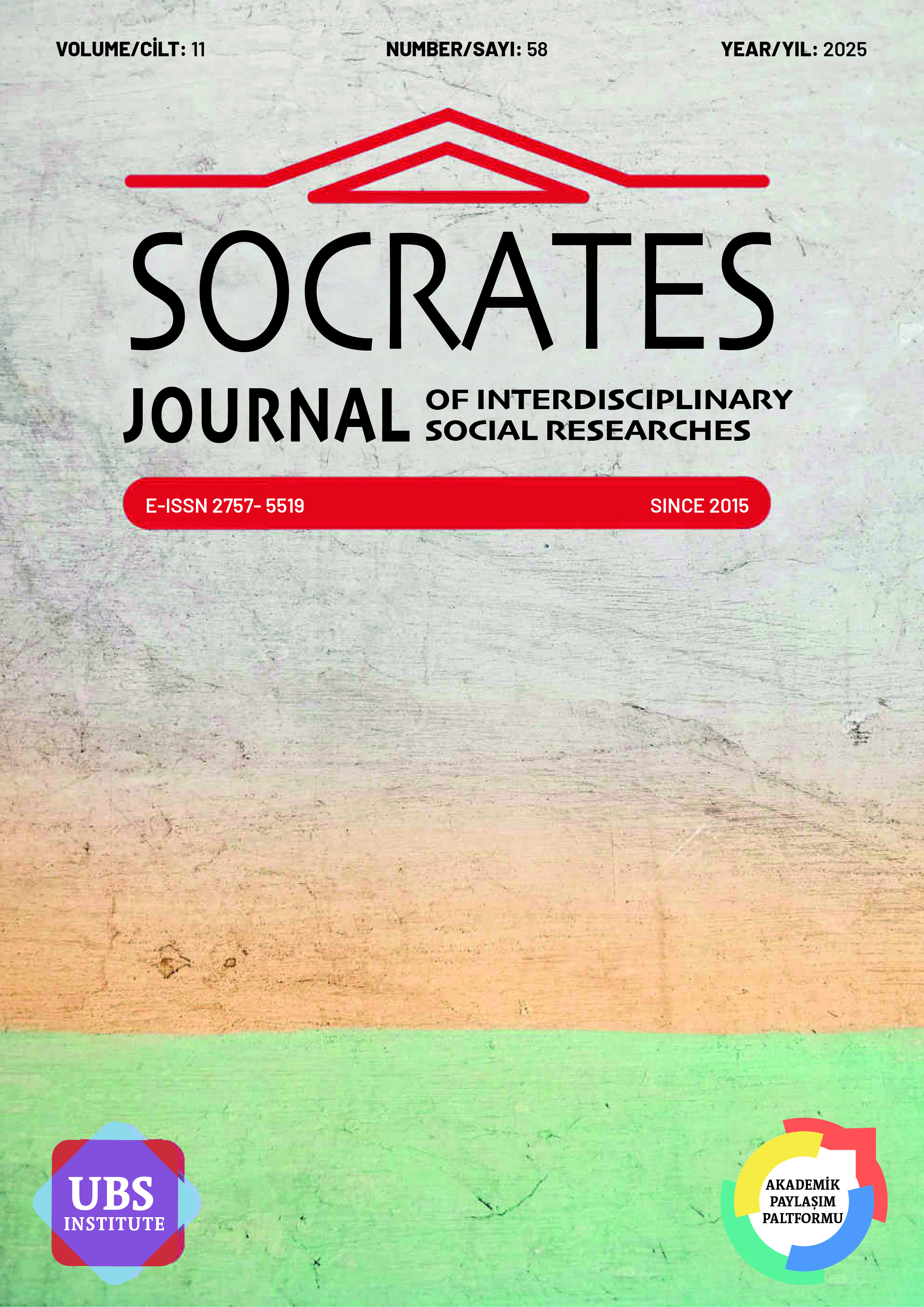İKİ MİSTİK GELENEK ARASINDA: TÜRK İSLAMI İLE ŞİNGON BUDİZMİ ÜZERİNE BİR DERLEME
BETWEEN TWO MYSTICAL TRADITIONS: A COMPARATIVE SURVEY OF TURKISH ISLAM AND SHINGON BUDDHISM
DOI:
https://doi.org/10.5281/zenodo.17443885Keywords:
Shingon Buddhism, Mysticism, Ritual, Secularization, Belief SystemsAbstract
This study provides a comparative examination of Turkish Islam, shaped through the secular reforms of the early Republican era, and the esoteric Shingon Buddhism rooted in tantric principles in Japan. It analyzes both traditions-across belief systems, ritual practices, metaphysical orientations, mystical experiences, symbolism, and social roles-within their historical and cultural contexts. Turkish Islam, following the abolition of the caliphate and the institutionalization of religion under the Directorate of Religious Affairs, took on a more normative and state-regulated form. In contrast, Shingon Buddhism preserved its ritual distinctiveness within temple-centered autonomous structures. Theologically, Turkish Islam emphasizes transcendence and revelation, whereas Shingon Buddhism privileges the intuitive and immanent realization of universal truth. Despite doctrinal and institutional differences, both traditions share mystical practices aimed at individual transformation and spiritual maturation. This study contends that religious experience, though culturally and historically situated, reveals a universal foundation in the quest for transcendence and meaning.
References
Abé, R. (1999). The weaving of mantra: Kukai and the construction of esoteric Buddhist discourse. Columbia University Press.
Akduman, A., & Arı, Y. (2024). Cumhuriyet döneminde toplumsal değişim ve din: Etkileşimler ve dönüşümler. Journal of Analytic Divinity, 8(2), 252-273.
Algar, H. (1976). The Naqshbandī order: A preliminary survey of its history and significance. Studia Islamica, 44, 123-152.
Dokuyan, S. (2021). Tekkelerin kapatılması ve tasfiye süreci 1925-1938. Türk Kültürü ve Hacı Bektaş Veli Araştırma Dergisi, (98), 217-244.
Eser, H. B. (2013). Türk siyasal kültürü içinde dinin rolü üzerine bir açıklama çabası: Milli Görüş Hareketi ve Milli Nizam Partisi. Süleyman Demirel Üniversitesi İktisadi ve İdari Bilimler Fakültesi Dergisi, 18(3), 201-224.
Faure, B. (1996). Visions of power: Imagining medieval Japanese Buddhism. Princeton University Press.
Gablankowska-Kukucz, J. (2015). Initiation rituals in Shingon and Tibetan Buddhism. The Polish Journal of the Arts and Culture. New Series, 2(2), 43-53.
Gardiner, D. (2008). Metaphor and maṇḍala in Shingon Buddhist theology. Sophia, 47, 43-55.
Gardiner, D. (2018, August 28). Tantric Buddhism in Japan: Shingon, Tendai, and the Esotericization of Japanese Buddhisms. Oxford Research Encyclopedia of Religion. Retrieved 11 Oct. 2025, from https://oxfordre.com/religion/view/10.1093/acrefore/9780199340378.001.0001/acrefore-9780199340378-e-619.
Giebel, R. W., & Todaro, D. A. (2004). Shingon texts. Numata Center for Buddhist Translation and Research.
Kadıoğlu, A. M. (2024). Atatürk Dönemi’nde Japonya ile ticari ilişkiler (1923-1938). Türklük Bilimi Araştırmaları, (56), 89-102.
Kadıoğlu, A.M. (2022). Japon modernleşmesi üzerinden Türkiye ve Japonya ekonomik ilişkileri, Journal of Communication, Sociology and History Studies, 2(1), 15-22.
Kara, İ. (2003). Türkiye'de İslamcılık düşüncesi. Dergâh Yayınları.
Karataş, H. (2013). Erken dönem Japon Budizmi. Fırat Üniversitesi İlahiyat Fakültesi Dergisi, 18(2).
Kaygusuz, İ. (2019). Bir dinî grup olarak Mevleviler (Sosyolojik bir araştırma: Konya örneği). Süleyman Demirel Üniversitesi Sosyal Bilimler Enstitüsü.
Kiyota, M. (1968). Shingon mikkyō maṇḍala. History of Religions, 8(1), 31-59.
Matsunaga, Y., & Pruden, L. (1969). Tāntric Buddhism and Shingon Buddhism. The Eastern Buddhist, 2(2), 1-14.
Nasr, S. H. (2001). İslam ve modern insan (H. Türker, Trans.). İnsan Yayınları.
Necipoğlu, G. (2005). The age of Sinan: Architectural culture in the Ottoman Empire. Princeton University Press.
Nicoloff, P. L. (2007). Sacred Kōyasan: A pilgrimage to the mountain temple of Saint Kōbō Daishi and the Great Sun Buddha. State University of New York Press.
Ocak, A. Y. (1996). Türkler, Türkiye ve İslam. İletişim Yayınları.
Onat, Ş. C. (2023). Kūkai’nin Mandala konsepti ile Mark Rothko Şapeli’nin analojisi. İdil, 12(106), 738-749.
Öner, M. ve Erol, M. (2025). Türk kültüründe şaman: Ritüel hareketin bedensel ifadesinde dönüş. Avrasya Uluslararası Araştırmalar Dergisi, 13(43), 285-308.
Özdalga, E. (1996). Modernleşme ve din. Metis Yayınları.
Proffitt, A. (2022). Shingon. In Oxford Research Encyclopedia of Religion.
Reader, I., & Tanabe, G. J. (1998). Practically religious: Worldly benefits and the common religion of Japan. University of Hawai’i Press.
Sanford, J. H. (1997). Wind, waters, stupas, mandalas: Fetal Buddhahood in Shingon. Japanese Journal of Religious Studies, 24(1-2), 1-38.
Snodgrass, A. (1987). Interpenetration and Shingon ritual practice. Religious Traditions, 10(1), 31-45.
Şenavcu, H. İ. (2016). Tarihsel süreç içerisinde Japon Budizmi: Genel bir bakış. Türkiye Din Eğitimi Araştırmaları Dergisi, 1, 42-64.
Terzioğlu, H. (2012). Kur’an’da inanç esaslarının aklî yöntemle temellendirilmesi. KADER Kelam Araştırmaları Dergisi, 10(2), 203-220.
Tinsley, E. (2011). Kūkai and the development of Shingon Buddhism. In C. Lopez (Ed.), Esoteric Buddhism and the Tantras in East Asia (pp. 691-708). Brill.
Toprak, H. (2017). Türkiye Cumhuriyeti’nde dinî kurumsallaşma: Diyanet İşleri Başkanlığı’nın kuruluşu. Muhafazakâr Düşünce Dergisi, 14(51), 217-233.
Trimingham, J. S. (1999). Sufi orders in Islam. Oxford University Press.
Winfield, P. D. (2019). Shinnyo-en and the formulation of a new esoteric iconography. Material Religion, 15(1), 27-53.
Yamasaki, T. (1988). Shingon: Japanese esoteric Buddhism. Shambhala Publications.
Downloads
Published
How to Cite
Issue
Section
License
Copyright (c) 2025 Socrates Journal of Interdisciplinary Social Studies

This work is licensed under a Creative Commons Attribution 4.0 International License.


